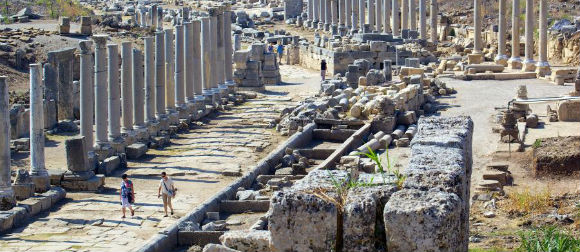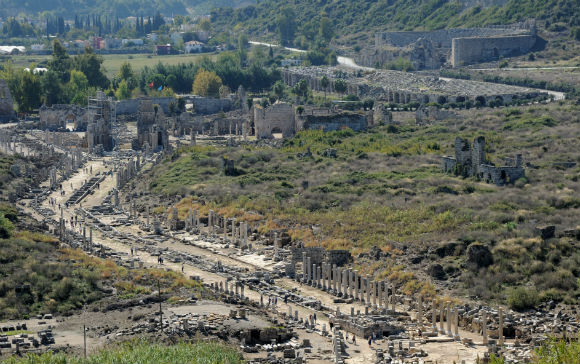The most impressive ruins of the Pamphylian coast are at Perge, at about 15 km east of Antalya. Perge was originally founded by the Hittites around 1500 BC. and was known as Parha. It was a successful trading centre near the Aksu (ancient Kestros or Cestrus) river when Alexander the Great arrived in 333 BC. He was welcomed in by the inhabitants and used Perge as base for his Anatolian campaigns. Alexander was followed by the Seleucids under whom the city prospered and Perge’s most celebrated inhabitant, the mathematician Apollonius from Perge lived and worked. Apollonius was a pupil of Archimedes and wrote a series of eight books on geometry. In 188 BC Perge became part of the Roman Empire during which the city flourished. Most of the surviving buildings date from this period.In 46 AD St. Paul started his journey in Perge (biblical Perga) and preached his first sermon here. Perge gradually declined during the Byzantine period, as the Aksu river silted, but remained inhabited until Selçuk times after which it became abandoned.
A visit to Perge starts by entering the archeological site through the Roman Gate, built during the reign of Septimius Severus (193-211 AD). Proceeding through the gate, to the right is the Agora or market place. This structure of 75 x 75 m dates back from the 2nd century AD. The center courtyard and shops were surrounded by a wide stoa, a covered walkway. The floor of the stoa and shops was made of colored mosaics. The agora was not only the centre of Perge’s trade, but was also a place for meetings as well as a forum for political, social, and philosophical discussions. The next building is the Hellenistic city gate that dates back to the 3rd century BC. This is certainly the most imposing building of the city and was cleverly designed to protect the city with its twin towers and its horseshoe-shaped courtyard at the back. It is thought that the towers had three floors and were crowned by a conical roof. In the year 121 AD, the horseshoe-shaped courtyard was rededesigned as a courtyard of honor. Behind the courtyard stood a triple arch. Around the arch there are about dozen inscriptions connected with Plancia Magna who lived in the 2nd century AD. She was the daughter of the governor, a priestess of Artemis Pergaia (Diana) and a benefactress to the city. Plancia Magna had the arch decorated with the statues of the emperors and their relatives.
After passing through the Hellenistic Gate and courtyard, one enters a broad, marble-paved double-colonnaded street measuring 300 meters in length that extends from the main gate to the acropolis. The street is 20 m wide and is divided in two by a 2 meter wide water channel running down the middle. At the end of the colonnaded street is the Nymphaeum, a triumphal fountain from where a stream flowed down into the water channel. The nymphaeum or nymphaion is an ornamental semicircular structure and dates from the reign of Emperor Hadrian (130-150 AD). A statue of a river god Kestros was located in the center of this huge fountain. Behind the nymphaeum is the acropolis with some remains of the Byzantine period. To the west of the nymphaeum are the remains of a palaestra dating from 50 AD and dedicated to the Emperor Cladius (41-54 AD).
Returning back to the entrance, there are the excavated Roman baths located southwest to the agora. Out of the site proper, is the horsehsoe-shaped stadium, the largest in Asia Minor, measuring 234 m by 34 m. The stadium had a seating capacity of 12,000 people supported by massive barrel-vaulted constructions. Just beyond the site entrance is also the theatre, which is of the Greco-Roman type and could seat 15,000 people. Unfortunately, it is for some time under reconstruction and unfortunately closed to visitors.
Perge,



This unlike a ancient ruin in the uk you could really climb into the past by geeting in to the city with no barriers or grumpy stewards saying do not touch. the guide was also fantastic
The city is great and I will let other reviewers address this. I am simply updating mass transit instructions for people who want to save a bit of money.
From Kaleici (old town Antalya) you can catch the new tram (Antray) to the Meydan stop. It cost me 2TL each way.
At the Meydan stop you will see a bus…
This is a large site, with a number of structures still standing, including a magnicient entrance. The bath area is large and well preserved. As you walk the agora area you can almost hear the hawkers calling our inviting you into their businesses.
Amazing gem of a history and excavation relics from 2nd century AD to end of Roman empire. Hellinistic and Alexandrean periods are best preserved.Takes around 45 minutes from Antalya and there are several tour companies. We paid £45 each including Lunch and visit to Espandos amphitheatre.
We went to Perge on a Tuesday at the end of January and because it was the off-season it was only the two of us by the ruins. It was an amazing experience to walk around the site only by ourselves, looking around the beautiful, ancient city. We also drove to the village nearby which was small and sympathetic.
We…
We took the bus tour to Perge & Aspendos from Side. If you are interested in ancient history this is a great site to visit. Founded around 1000 BC and credited as one of the first cities to produce beer all beer lovers should make a pilgrimage to this site. In 333 BC the armies of Alexander The Great arrived….
Very well preserved ancient site, We meant to walk around detailed but it was too cold! You need to learn the history first!! then imagine…
Because the crowds were much smaller, we were able to linger at the various sites, and to gather around out guide and really hear what he had to say. The stadium was especially impressive, and the only one of its kind we saw while in Turkey
Some areas closed due to excavation, including the amphitheatre. Still worth a visit though as it's big enough. Have a small bottle of water with you as you walk around. A fair few tour groups so if you can get a hire car and arrive early it'd be quieter. Give yourself at least two hours if you want a good…
Turkey is just awash with Roman cities,buildings and artifacts.Thought I'd seen it all with Ephesus and Apollo Temple,Aspendos then we saw this place,just blows you away.Buildings for the rich and poor,Temples,roads,ampitheatre,fighting arena and chariot racing arena,could spend all day walking round this place and go back the next day.If you like history and how the romans lived then this is…